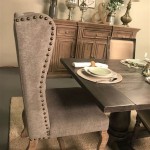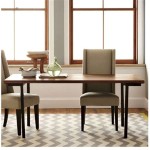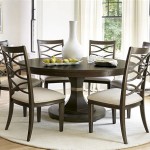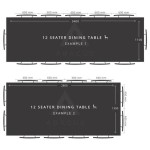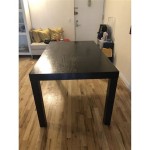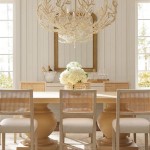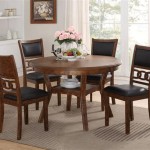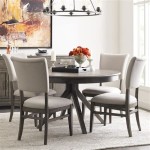Extendable Dining Tables: Optimizing Small Spaces
In contemporary urban living, the desire for spaciousness often clashes with the reality of limited square footage. Dining areas, in particular, can present a design challenge, requiring furniture that is both functional and space-conscious. Extendable dining tables emerge as a practical and stylish solution, offering the flexibility to accommodate varying numbers of people without permanently occupying a large footprint.
An extendable dining table, also known as an expanding or drop-leaf table, is designed to alter its size, typically through the addition of leaves, folding mechanisms, or sliding sections. This adaptability allows the table to function as a compact surface for daily use while readily expanding to comfortably seat guests during gatherings. Choosing the right extendable dining table for a small space requires careful consideration of several factors, including the size and shape of the room, the intended frequency of expansion, the materials used, and the overall aesthetic.
Understanding the Benefits of Extendable Tables in Confined Areas
The primary advantage of an extendable dining table lies in its space-saving capabilities. In a small apartment or condo, every square inch counts. A standard dining table, even a small one, can permanently occupy a significant portion of the available area, potentially hindering movement and limiting other furniture arrangements. An extendable table, in its collapsed state, minimizes its footprint, freeing up valuable space for other activities or furniture. This versatility allows residents to maximize the functionality of their living areas without sacrificing the ability to host meals or entertain guests.
Beyond spatial efficiency, extendable tables offer a notable degree of versatility. They can seamlessly transition from a cozy setting for two to a more expansive dining area for larger groups. This adaptability eliminates the need for multiple tables or makeshift arrangements when hosting, providing a consistent and aesthetically pleasing dining experience. The ability to quickly and easily adjust the table's size also makes it suitable for a variety of activities beyond dining, such as crafting, working, or gaming.
Furthermore, extendable dining tables can contribute to the overall aesthetic appeal of a small space. Many designs are available in a wide range of styles, materials, and finishes, allowing residents to select a table that complements their existing décor. By choosing a table that is both functional and visually appealing, homeowners can enhance the perceived size and harmony of their living area. A well-chosen extendable table can serve as a focal point that enhances the overall design of the room rather than simply being a utilitarian piece of furniture.
Types of Extendable Table Mechanisms and Their Suitability for Small Spaces
The specific mechanism used to extend a dining table significantly impacts its ease of use, storage requirements for the leaves, and overall stability. Several common types of mechanisms are available, each with its own strengths and weaknesses.
Drop-leaf tables feature hinged sections that fold down to reduce the table's size. These are a simple and relatively inexpensive option, ideal for very small spaces where occasional expansion is needed. However, drop-leaf tables typically offer less seating capacity than other extendable options and may not be as stable when fully extended. The leaves are permanently attached, which can be both a pro and con. It's convenient, but the attached leaves can impact the aesthetic when folded down.
Butterfly leaf tables utilize a leaf that is stored within the table itself and unfolds like butterfly wings. This type of extension is convenient and eliminates the need for separate leaf storage. The butterfly mechanism is often found in smaller to medium-sized tables and provides a relatively smooth and stable extension. Because the leaf is stored internally, these tables can be slightly more expensive than drop-leaf options.
Extension tables with separate leaves are the most common type. These tables have a mechanism that allows the tabletop to be pulled apart, creating space for one or more leaves to be inserted. This design offers the greatest flexibility in terms of seating capacity and allows for multiple configurations. However, it requires separate storage for the leaves, which can be a consideration in a small space. The leaves can sometimes be stored within the table base itself, depending on the design.
Gateleg tables have legs that swing out to support the extended leaves. This design is particularly well-suited for narrow spaces as the table can be almost entirely folded down when not in use. Gateleg tables often evoke a traditional aesthetic and are suitable for smaller dining areas or as accent tables that can be expanded when needed.
Sliding tables operate by sliding one or both halves of the tabletop apart to reveal a space for inserting a leaf or leaves. This mechanism is often found in modern and contemporary designs and provides a clean and seamless look. Sliding tables can offer excellent stability and are suitable for larger extensions, but they may require more floor space to operate smoothly.
Key Considerations When Selecting an Extendable Table for Limited Square Footage
Choosing the right extendable dining table for a small space requires careful consideration of several critical factors. These considerations ensure that the table not only fits the available space but also meets the user's needs in terms of functionality, aesthetics, and durability.
The size and shape of the room are paramount. Before making a purchase, measure the available space and consider the table's dimensions in both its collapsed and extended states. Ensure that there is sufficient clearance for chairs and movement around the table. A round table can be beneficial in small spaces because it promotes easier traffic flow and can often accommodate more people than a rectangular table of similar size. However, the shape of the room might make a rectangular table a more efficient use of space.
The frequency of expansion is another important consideration. If the table will be expanded frequently, prioritize ease of use and a robust extension mechanism. Tables with butterfly leaves or built-in storage for the leaves may be more convenient for frequent use. If the table is only expanded occasionally, a simpler and less expensive mechanism may suffice. Consider the physical effort required to extend the table and choose a model that is manageable for all users.
Material selection impacts both the aesthetic and durability of the table. Solid wood tables offer a classic and durable option but can be more expensive and require more maintenance. Veneer tables provide a more affordable alternative with a similar aesthetic. Laminate tables are highly durable and resistant to scratches and stains, making them a practical choice for families with children or pets. Metal tables offer a modern and industrial look and are often highly durable. The choice of material should align with the overall design aesthetic of the room and the user's lifestyle.
The storage of leaves is often overlooked. Consider where the leaves will be stored when not in use. If space is limited, prioritize tables with built-in leaf storage or choose a drop-leaf or butterfly leaf design. Ensure that the storage location is easily accessible and that the leaves are protected from damage. A designated storage bag or container can help to keep the leaves clean and organized.
Finally, consider the style and aesthetic of the table. Choose a table that complements the existing décor and enhances the overall ambiance of the room. A minimalist design can help to create a sense of spaciousness, while a more ornate table can add character and personality. Pay attention to the details, such as the shape of the legs, the finish of the tabletop, and the overall proportions of the table. A well-chosen extendable dining table can be a valuable addition to a small space, providing both functionality and style.
By carefully considering these factors, individuals can select an extendable dining table that effectively optimizes their small space, providing a versatile and stylish solution for dining and entertaining.

Extendable Tables For Small Spaces Nordic Design Furniture

Villiers Japandi Extendable Dining Table Black Only

Asturn Modern Extendable Dining Table

Modern Extendable Dining Table Rectangle Sideboard With Storage In White Homary

Homcom Extending Kitchen Table For Six Drop Leaf Tables Small Spaces Folding Dining Dark Grey Aosom Canada

Extendable Kitchen Table For 2 4 Folding Drop Leaf Dining Natural

5 Pieces Folding Extendable Dining Table Set With 4 Chairs For Peoples 55 Drop Leaf Wood Kitchen Room Storage And 6 Wheels

Dining Table For Small Spaces Extendable Adler By Draenert

Best Extendable Dining Tables The Independent

Rovibek Foldable Dining Table For 2 6 Drop Tables Singapore U

